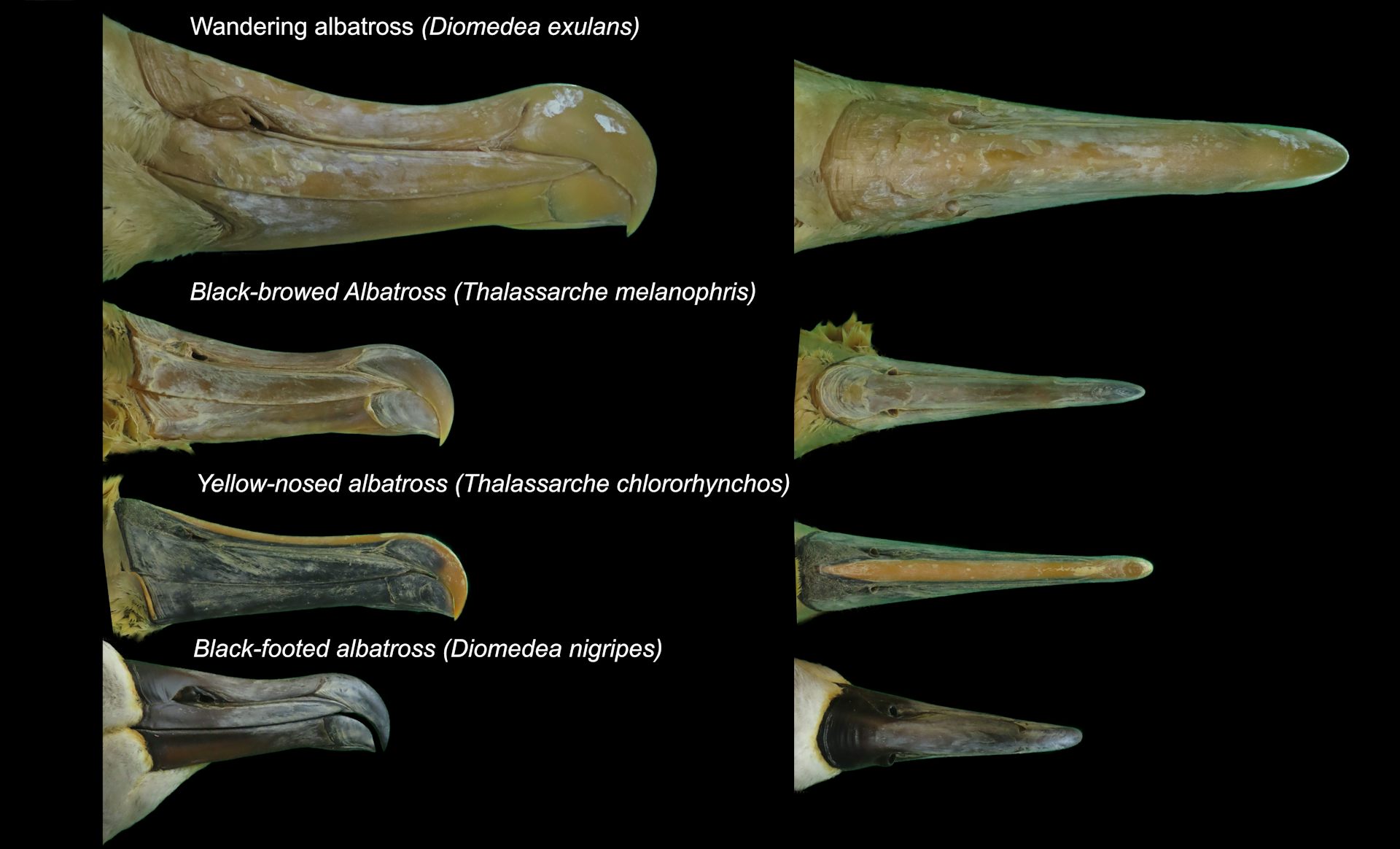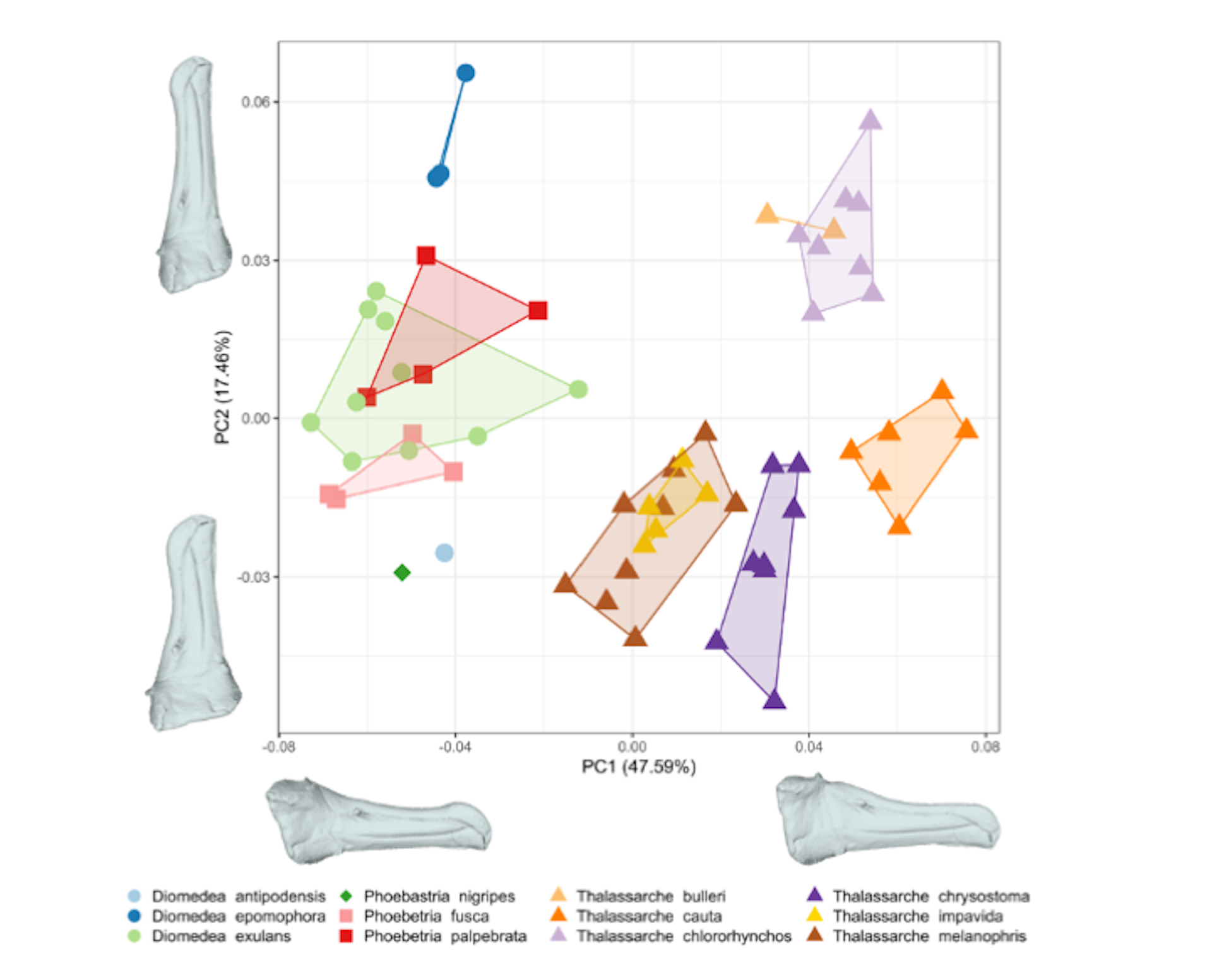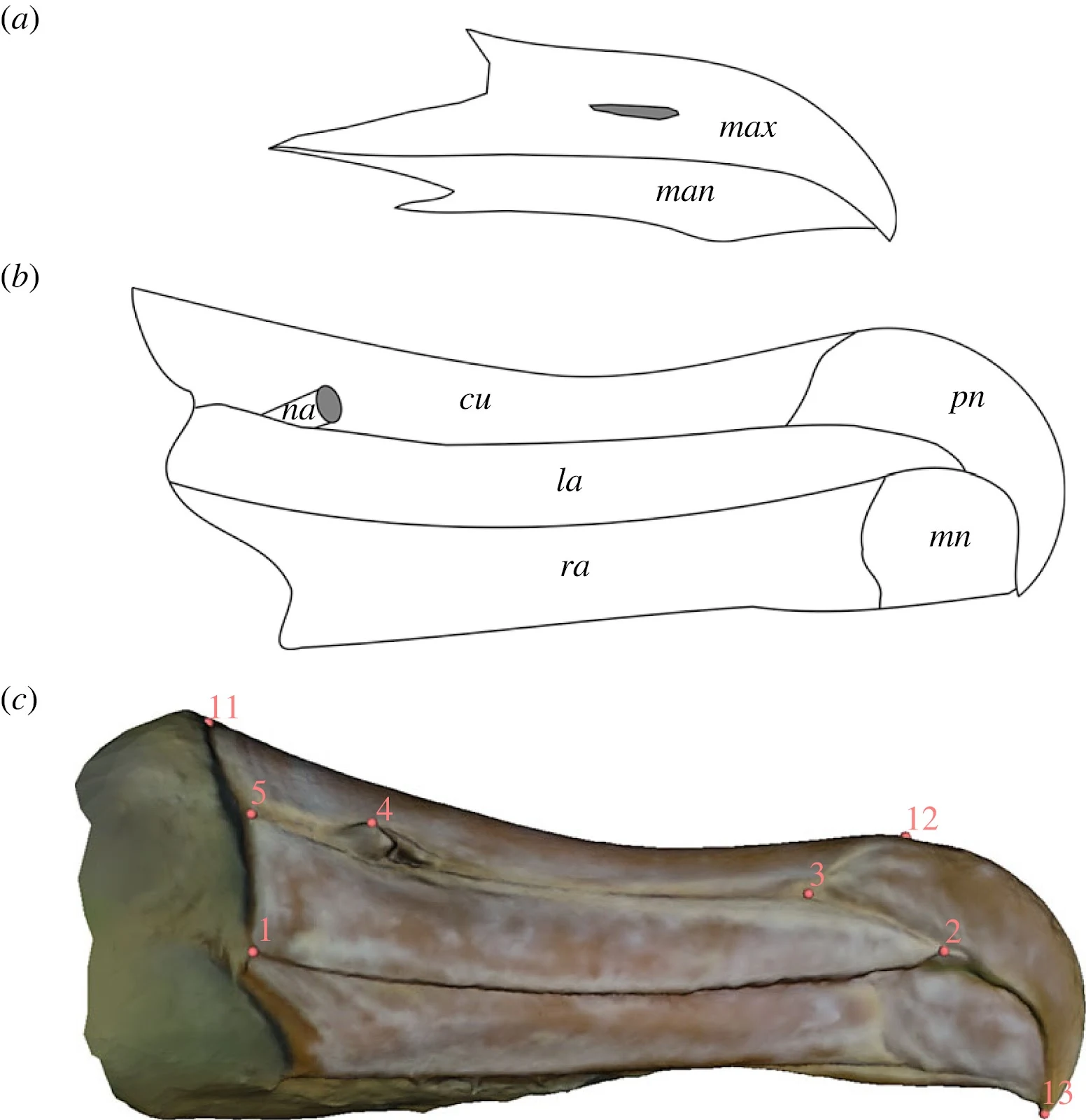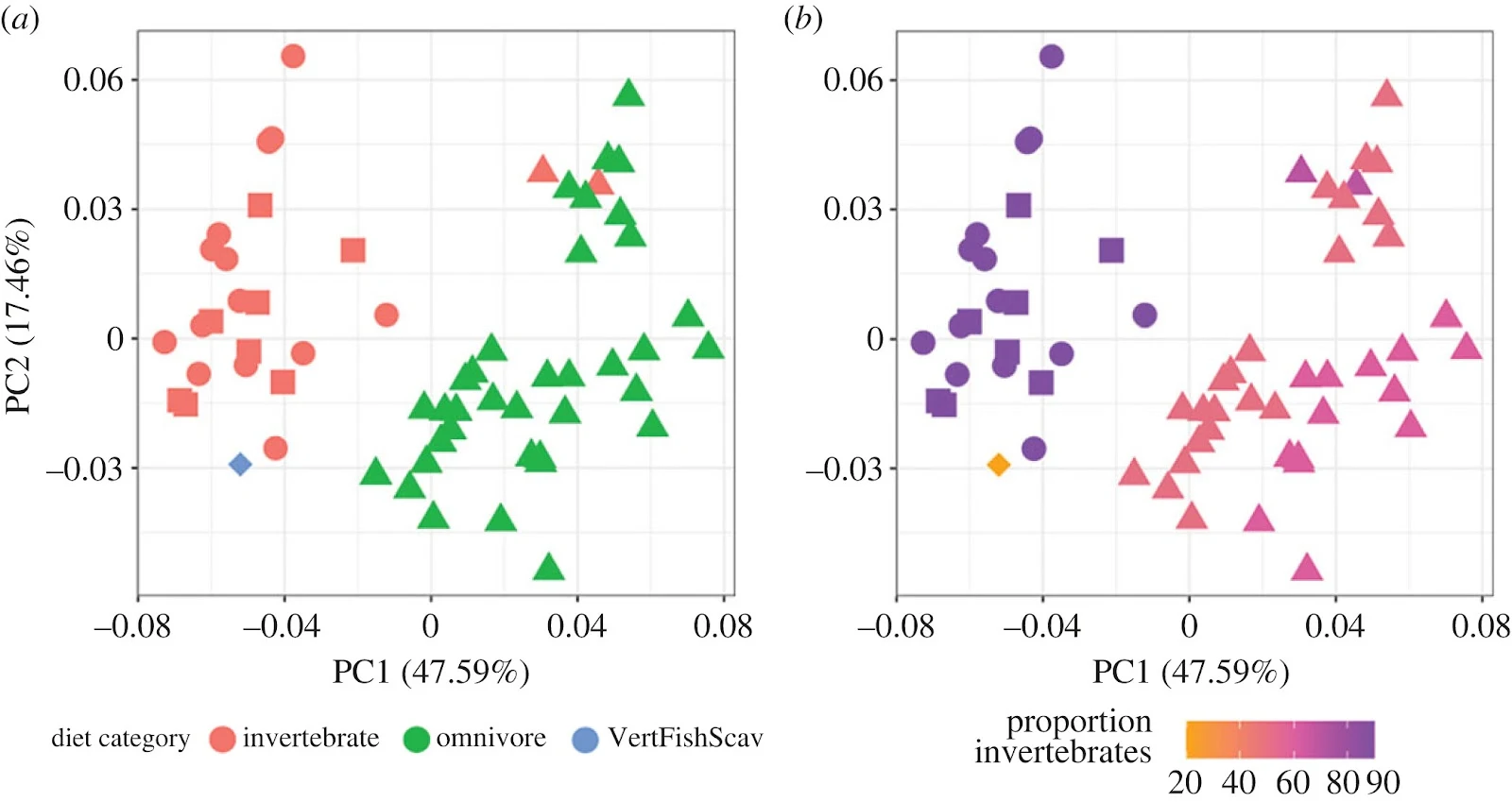
Wandering albatross, Diomedea exulans, widest wing-span of any bird
Image: picture-alliance/blickwinkel/K. Wothe
Just as Darwin's finch’s beaks did, albatross’ beaks have diversified as the different species diversified from a common ancestor, and the driving force is again the food they eat.
This is the finding of three biologists, Josh Tyler, a Postgraduate Research Student in the Department of Life Sciences, University of Bath, UK, Jane Younger, Lecturer, Southern Ocean Vertebrate Ecology, University of Tasmania, Australia and David Hocking, Adjunct Research Associate, Monash University, Australia.
And of course, it's bad news for creationists who have been fooled into thinking biologists are abandoning the Theory of Evolution in favour of their childish superstition with its belief in magic and supernatural deities.
The scientists have published their findings, open access in the journal Royal Society Open Science and have written about their research in The Conversation. Their article is reprinted here under a Creative Commons licence, reformatted for stylistic consistency:

Thick ones, pointy ones – how albatross beaks evolved to match their prey
Milan Sojitra, CC BY-ND 4.0
Jane Younger, University of Tasmania; David Hocking, Monash University, and Josh Tyler, University of Bath
Albatross are among the world’s largest flying birds, with wingspans that can stretch beyond a remarkable three metres. These majestic animals harness ocean winds to travel thousands of kilometres in search of food while barely flapping their wings.
Young albatross, embarking on their first journey, can spend up to five years at sea without ever touching land.
Yet not all albatross are the same. Across the world’s oceans there exist 22 species, with many sharing an overlapping range around the Southern Ocean — a region synonymous with cold, roaring winds and towering waves.
Our new research published today shows how albatross species evolved different beak shapes to make the most of the ocean’s food resources. These species have adapted to different seafood diets.

A grey-headed albatross (Thalassarche chrysostoma) showing its striking yellow and black compound beak.
Bryce Robinson, CC BY-ND
An ocean like no other: the Southern Ocean's ecological richness and significance for global climate
Move over, Darwin’s finches!In 1835 Charles Darwin discovered the finches of the Galápagos Islands and noted their beaks varied in shape and size to suit different diets. This observation became a centrepiece for the theory of evolution, showing how species adapt to different ways of life.
From a single common ancestor, Darwin’s finches diversified. Some birds have thick beaks for feeding on seeds and nuts, while others have pointed beaks for eating insects. This variation allows species to specialise, helping them to share available food sources and limit competition.
Albatross have fascinating beaks. Unlike most other birds, they have a “compound” beak made of multiple pieces of keratin. Albatross spend most of their lives at sea, so they have adapted to drink seawater. They use a special gland to remove salt from the seawater and their beaks contain tube-like passages that excrete the salty liquid.
By studying the shape of albatross beaks in three dimensions (3D), our new research shows that, just like Darwin’s finches, albatross beaks vary in size and shape to adapt to different diets.

Albatross have compound beaks made of multiple pieces of keratin. These vary in size and shape between the different species.
Josh Tyler, CC BY-ND
The 3D scanning revolution
Wildlife research is undergoing a revolution as scientists use new 3D scanning and modelling techniques to compare the anatomy of animals. This gives fresh insights into their ecology and evolution.
Using museum specimens, we made 3D digital models of beaks for 61 birds from 12 different albatross species. We compared the size and shape of different species’ beaks. We tested if closely-related species had similar beaks. Alternatively, beaks might be more alike between species that are distantly related but consume similar food. Such a pattern would be an example of convergent evolution.
We found beak size and shape varied between albatross species, making it a useful tool for identifying species that otherwise look similar.
Beaks also varied between species that eat either invertebrate prey, fish, or a mixture of both. Even in species that have similarly shaped beaks and diets, variations in beak size enable them to focus on prey of different sizes within the same category, such as small versus large fish.
The variation is most obvious in changes in the length and thickness of the beaks, but they can also vary in how the separate keratin pieces come together to make up the whole shape of the beak. These differences help albatross species to avoid competition with each other as they forage together over the open ocean.

3D analysis shows how albatross species beaks can differ in both size and proportion. They also vary in how the keratin pieces fit together to make the overall shape of the bill.
Josh Tyler, CC BY-ND
A future for albatross?
This research was made possible by the large collection of more than 750 albatross specimens preserved at the Tasmanian Museum and Art Gallery.
Almost all of these specimens came to the museum after being caught as bycatch in past longline fisheries, where bird carcasses were collected to identify which species were being captured on hooks.
Fortunately, improved fishing methods have reduced albatross bycatch, but this collection now remains as a valuable resource for new research like this into the biology of these birds.
Sadly, fisheries are not the only threat these extraordinary birds face. The first European record of an albatross from 1593 tells us how the bird was captured, killed and eaten. Today, of the 22 albatross species, two are considered critically endangered, seven species are endangered, and a further six species are considered vulnerable.
Albatross are still frequent victims of fisheries bycatch, plastic pollution, and introduced predators on their breeding islands.
Like most wildlife species, the persistent threat of climate change looms large, as the world’s oceans warm and alter their habitat and the abundance of their prey.
Despite their evolutionary marvels and remarkable adaptations to the harshest ocean on Earth, the albatross serves as a poignant reminder of nature’s fragility. It is our duty to ensure their wings continue to soar above our oceans for generations to come.

The southern Royal albatross (Diomedea epomophora) in flight.
Julie McInnes, CC BY-ND
Jane Younger, Lecturer, Southern Ocean Vertebrate Ecology, University of Tasmania; David Hocking, Adjunct Research Associate, Monash University, and Josh Tyler, Postgraduate Research Student, Department of Life Sciences, University of Bath
This article is republished from The Conversation under a Creative Commons license. Read the original article.
AbstractAs the Theory of Evolution by Natural Selection predicts, the size and shape of the different albatross species' beaks is the result of environmental drivers. In particular, as with Darwin's finches, their main food resources. It doesn't take a genius to work out that individuals with beak shapes that give them an advantage over other members of their species will survive to produce more offspring and this will drive the evolution of beaks towards greater fitness for purpose.
Albatross are the largest seabirds on Earth and have a suite of adaptations for their pelagic lifestyle. Rather than having a bill made of a single piece of keratin, Procellariiformes have a compound rhamphotheca, made of several joined plates. Drivers of the shape of the albatross bill have not been explored. Here we use three-dimensional scans of 61 upper bills from 12 species of albatross to understand whether intrinsic (species assignment & size) or extrinsic (diet) factors predict bill shape. Diet is a significant predictor of bill shape with coarse dietary categories providing higher R2 values than dietary proportion data. We also find that of the intrinsic factors, species assignment accounts for ten times more of the variation than size (72% versus 6.8%) and that there is a common allometric vector of shape change between all species. When considering species averages in a phylogenetic framework, there are significant Blomberg's K results for both shape and size (K = 0.29 & 1.10) with the first axis of variation having a much higher K value (K = 1.9), reflecting the split in shape at the root of the tree. The influence of size on bill shape is limited, with species assignment and diet predicting far more of the variation. The results show that both intrinsic and extrinsic factors are needed to understand morphological evolution.
Tyler Joshua, Hocking David P. and Younger Jane L. (2023)
Intrinsic and extrinsic drivers of shape variation in the albatross compound bill
R. Soc. open sci. 10230751230751; http://doi.org/10.1098/rsos.230751
Copyright: © [year] The authors.
Published by [publisher]. Open access
Reprinted under a Creative Commons Attribution 4.0 International license (CC BY 4.0)
 Figure 1. Compound Bill Morphology & Landmark Configuration. (a) Bill morphology of European herring gull (Larus argentatus) (b) Bill morphology of Wandering albatross (Diomedea exulans) (c) Landmarks 1–5 and 6–10 are paired (right-left) and landmarks 11–13 are found on the midline ( table 1 for descriptions). Specimen B5348 (Campbell Albatross Thalassarche impavida). Abbreviations for A & B: max maxilla, man mandible, na naricorn, cu culminicorn, la latericorn, pn premaxillary nail, ra ramicorn, mn mandibular nail.
Figure 1. Compound Bill Morphology & Landmark Configuration. (a) Bill morphology of European herring gull (Larus argentatus) (b) Bill morphology of Wandering albatross (Diomedea exulans) (c) Landmarks 1–5 and 6–10 are paired (right-left) and landmarks 11–13 are found on the midline ( table 1 for descriptions). Specimen B5348 (Campbell Albatross Thalassarche impavida). Abbreviations for A & B: max maxilla, man mandible, na naricorn, cu culminicorn, la latericorn, pn premaxillary nail, ra ramicorn, mn mandibular nail. Figure 2. Albatross study species. Cladogram showing the 12 species included in the analyses alongside dorsal and lateral images of representative specimens. Green coloration due to image processing. Original specimen labels for TMAG B4827 & TMAG B5854 listed Diomedea bulleri and Diomedea nigripes respectively.
Figure 2. Albatross study species. Cladogram showing the 12 species included in the analyses alongside dorsal and lateral images of representative specimens. Green coloration due to image processing. Original specimen labels for TMAG B4827 & TMAG B5854 listed Diomedea bulleri and Diomedea nigripes respectively.
 Figure 3. Shape and size. (a) Morphospace of first two principal components with convex hulls around species. (b) Morphospace of the third and fourth principal components with convex hulls around species. (c) Boxplot showing ranges of bill centroid size (key symbols used to identify bars where n = 1 or n = 2). (d) First two axes of the Size-Shape morphospace based on the 13 landmarks and centroid size data.
Figure 3. Shape and size. (a) Morphospace of first two principal components with convex hulls around species. (b) Morphospace of the third and fourth principal components with convex hulls around species. (c) Boxplot showing ranges of bill centroid size (key symbols used to identify bars where n = 1 or n = 2). (d) First two axes of the Size-Shape morphospace based on the 13 landmarks and centroid size data.
 Figure 5. Diet. Both plots present first two PCA axes matching figure 4A with corresponding shapes mapping to genera (Circle – Diomedea, Diamond – Phoebastria, Square – Phoebetria, Triangle – Thalassarche). (a) Morphospace showing three discrete dietary categories: Invertivore, Omnivore, Fish and Scavenging (b) proportion of invertebrates in diet as given by the EltonTraits database.
Figure 5. Diet. Both plots present first two PCA axes matching figure 4A with corresponding shapes mapping to genera (Circle – Diomedea, Diamond – Phoebastria, Square – Phoebetria, Triangle – Thalassarche). (a) Morphospace showing three discrete dietary categories: Invertivore, Omnivore, Fish and Scavenging (b) proportion of invertebrates in diet as given by the EltonTraits database. Figure 6. Comparison of three proposed allometric models predicting albatross bill shape. To test which allometric model best describes variation observed within albatross, three potential models (a–c). X-axis plots centroid size and y-axis plots Principal Component 1 of the fitted values of predicted shape (i.e. excluding the residuals) from the proposed regression. These panels are the equivalent of an R2 equal to 1. (a) Simple Allometric Model (shape∼Centroid Size) where all taxa follow the same allometry vector (b) Common Allometric Model (shape∼Centroid Size+species) where the gradients of shape change are the same but the means are different (i.e. each species shares the same gradient but have different intercepts) (c) Unique Allometric Model (shape∼Centroid Size ∗ species) where the gradients and intercepts for each species are different (i.e. inclusion of an interaction parameter) (d) Legend for plots (a–c).
Figure 6. Comparison of three proposed allometric models predicting albatross bill shape. To test which allometric model best describes variation observed within albatross, three potential models (a–c). X-axis plots centroid size and y-axis plots Principal Component 1 of the fitted values of predicted shape (i.e. excluding the residuals) from the proposed regression. These panels are the equivalent of an R2 equal to 1. (a) Simple Allometric Model (shape∼Centroid Size) where all taxa follow the same allometry vector (b) Common Allometric Model (shape∼Centroid Size+species) where the gradients of shape change are the same but the means are different (i.e. each species shares the same gradient but have different intercepts) (c) Unique Allometric Model (shape∼Centroid Size ∗ species) where the gradients and intercepts for each species are different (i.e. inclusion of an interaction parameter) (d) Legend for plots (a–c).
Click image to enlarge.
Evolution really is that simple.
As this piece of work shows, the biologists concerned had no doubt at all that the facts could be fully explained by the TOE with no need to include magic in the explanation.


No comments:
Post a Comment
Obscene, threatening or obnoxious messages, preaching, abuse and spam will be removed, as will anything by known Internet trolls and stalkers, by known sock-puppet accounts and anything not connected with the post,
A claim made without evidence can be dismissed without evidence. Remember: your opinion is not an established fact unless corroborated.